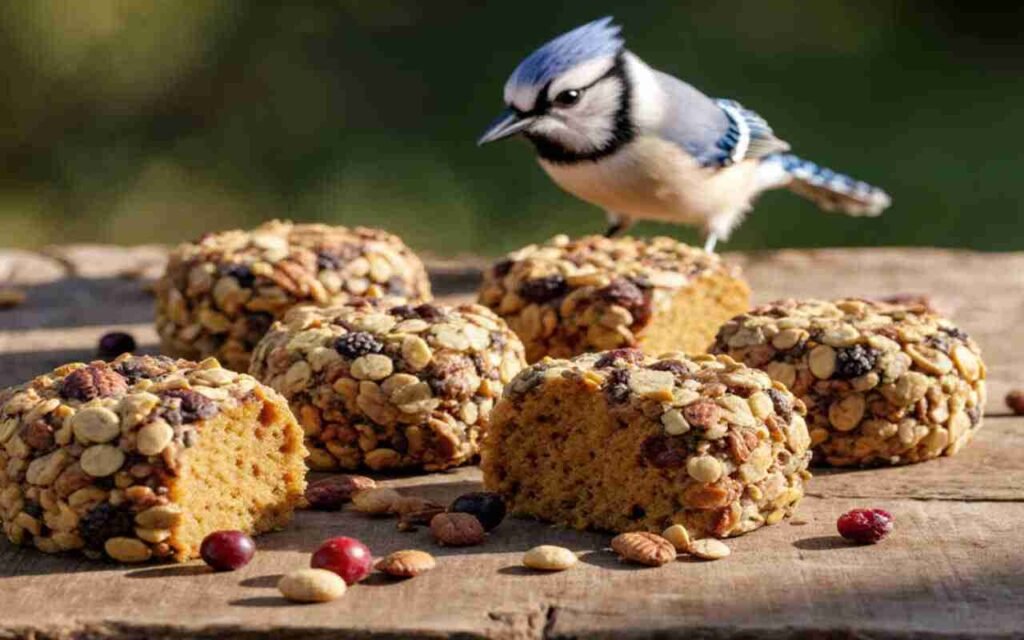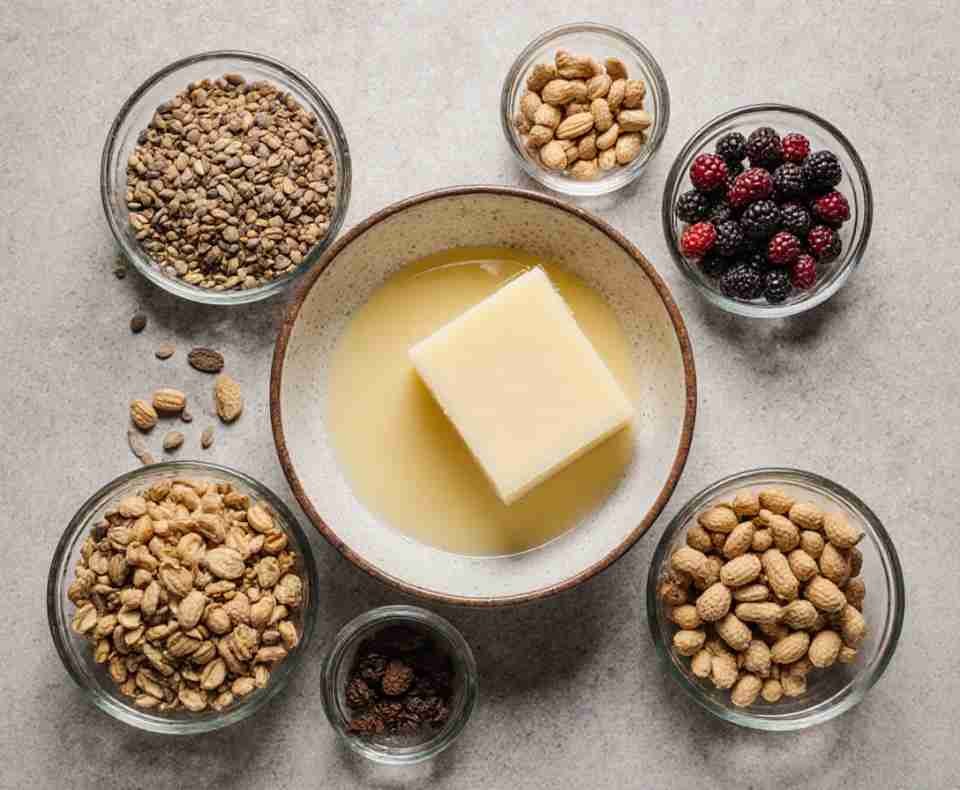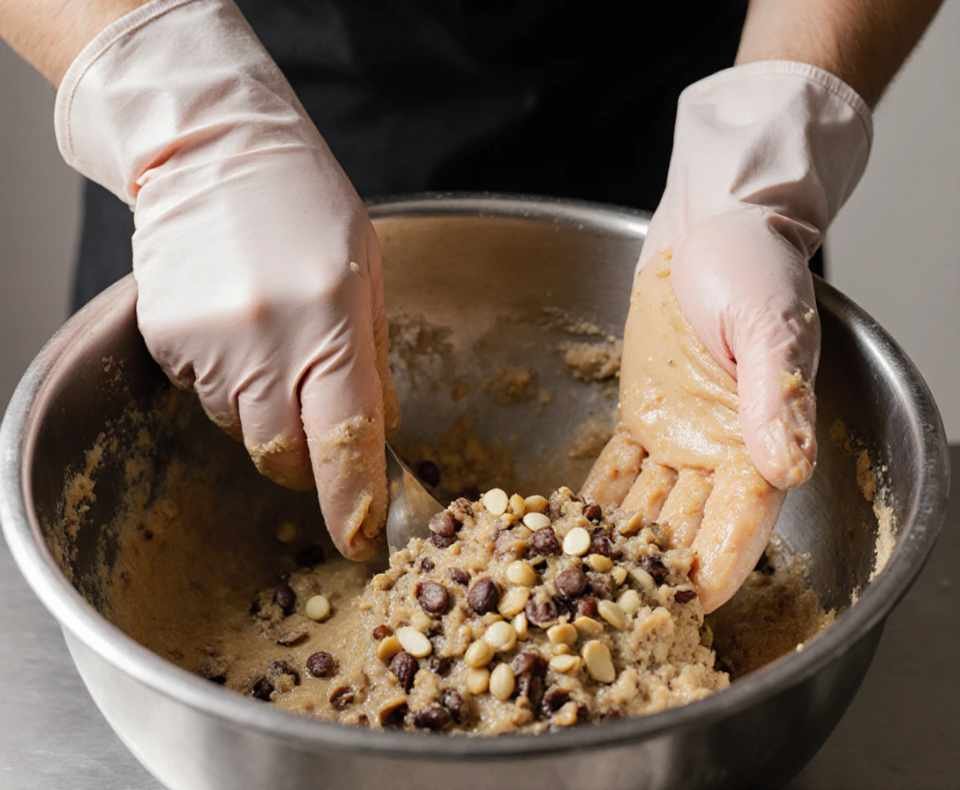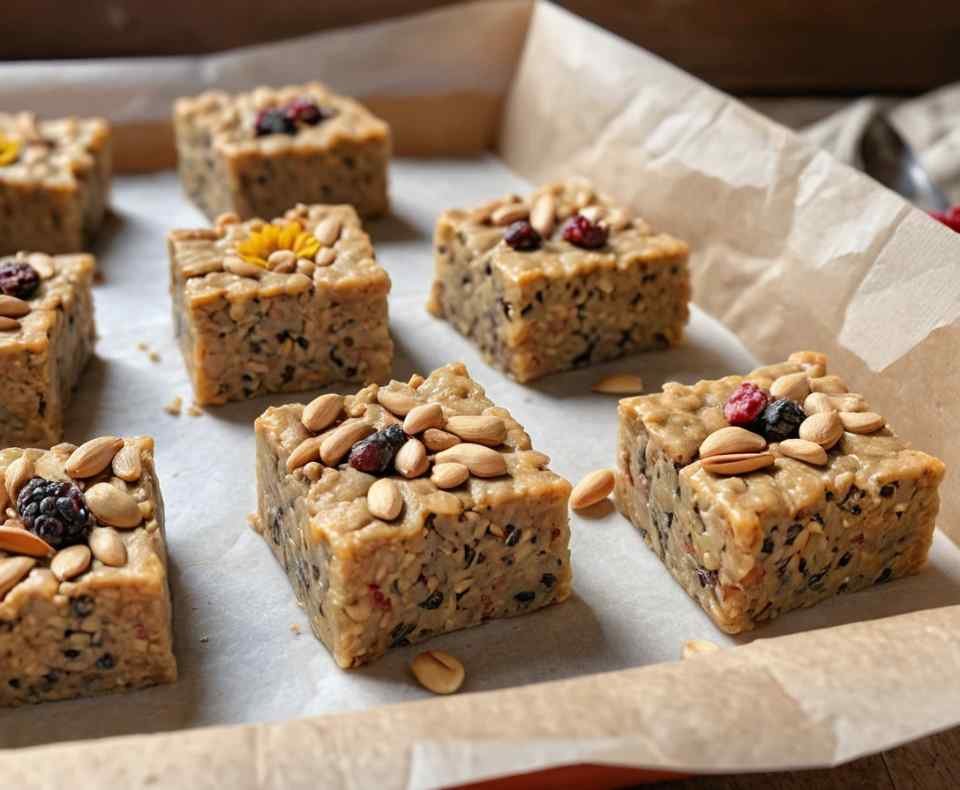Wondering how to make suet cakes for birds? Store-bought suet often costs a fortune, and half the time it melts into greasy disasters the moment temperatures hit 70 degrees. I learned this the hard way when my expensive ‘premium’ suet turned into bird food soup all over my deck last summer. That’s when I decided to master homemade bird suet recipes and never looked back.
Making your own DIY suet cakes for wild birds isn’t rocket science, but it does require knowing a few tricks to get the consistency right. I’ve been experimenting with different formulas for three years now, and I can honestly say my backyard birds prefer my homemade versions over anything from the store. Plus, you’ll save serious money while knowing exactly what goes into your bird food.
Let me walk you through everything I’ve learned about creating suet cakes that actually work.
Understanding Suet and Why Birds Need It
What Makes Suet Special
Suet provides the high-energy fats that birds desperately need, especially during cold weather and breeding seasons. Think of it as the bird equivalent of energy bars packed with calories and nutrients that keep them going. According to the University of Minnesota Extension, high-fat foods like suet are essential for wild birds during winter.
Wild birds burn enormous amounts of energy maintaining body temperature and flying around searching for food. Feeding wild birds in winter with quality suet can literally mean the difference between survival and starvation during harsh weather periods.
I started making suet after watching cardinals and woodpeckers struggle through a brutal February cold snap. Commercial suet seemed expensive for what you got, and I wanted more control over ingredients and quality.
Which Birds Love Suet Most
Woodpeckers absolutely go crazy for suet (and if you’ve ever wanted to tell them apart, this Downy vs Hairy Woodpecker guide comes in handy), but you’ll also attract nuthatches, chickadees, wrens, and even some unexpected visitors like blue jays and cardinals. Different bird species prefer different suet textures and ingredients.
Insect-eating birds especially benefit from suet during winter when bugs become nearly impossible to find. The fat content helps replace the protein and energy they’d normally get from insects during warmer months.
Ever wonder why some yards seem to host way more birds than others? Often it comes down to providing the right high-energy food sources like quality suet during critical times of year.
Choosing the Best Fat for Suet Cakes
Rendered Fat Options
Beef suet remains the traditional choice and works beautifully for most applications. You can ask your local butcher for raw suet fat, which you’ll need to render down yourself, or buy pre-rendered suet that’s ready to use. According to the Cornell Lab of Ornithology, using animal fats provides birds with essential energy without the harmful additives found in processed oils.
Lard works well too, though I find it tends to be softer than beef suet. Coconut oil has gained popularity recently because it stays firmer at higher temperatures, making it great for summer feeding.
I’ve experimented with different fat combinations and found that mixing beef suet with a small amount of coconut oil creates suet cakes that hold their shape better in warm weather while still providing the nutrition birds need.
What to Avoid
Skip vegetable oils, butter, and margarine completely. These fats can actually harm birds and don’t provide the right nutritional profile. Bacon grease might seem tempting, but the salt content and chemical preservatives make it unsuitable for bird consumption.
Shortening works in a pinch, but it lacks the nutritional density of animal fats that birds have evolved to utilize efficiently. IMO, if you’re going to make homemade suet, use ingredients that actually benefit your feathered visitors.
Always avoid fats that have been heavily salted or contain artificial additives. Birds’ digestive systems can’t handle the sodium levels and chemical compounds found in many processed fats.
According to Native Bird Care, using inappropriate fats like butter, margarine, or bacon grease can coat feathers, reducing insulation and waterproofing, which may lead to hypothermia or death.
Essential Ingredients for Homemade Suet
Base Ingredient Mix
Peanut butter serves as both a fat source and protein booster that birds absolutely love. I use natural, unsalted peanut butter without added sugar or oils. This ingredient alone will dramatically increase your suet’s appeal to woodpeckers and nuthatches.
Black oil sunflower seeds should be your go-to seed choice, especially since so many common backyard birds rely on them as a staple food. They’re high in fat and protein while being small enough that most birds can handle them easily. According to the National Wildlife Federation, black oil sunflower seeds are preferred by a wide variety of songbirds and woodpeckers due to their high fat content and digestibility.
White millet works well for ground-feeding birds, though it tends to attract house sparrows more than native species.
Cornmeal adds bulk and helps bind ingredients together while providing carbohydrates for energy.
Rolled oats work similarly and some birds enjoy the texture variation they provide.
Premium Add-Ins
Chopped peanuts elevate any suet recipe, though they do increase costs significantly.
Dried mealworms provide protein that insect-eating birds crave, especially during breeding season when they need extra nutrition for raising young.
Dried fruit like cranberries or raisins appeals to different bird species and adds variety to your suet offerings. I chop large pieces into smaller bits so tiny birds can manage them more easily.
Crushed eggshells provide calcium that’s especially important for female birds during breeding season. Just make sure you sterilize them by baking at 200 degrees for 10 minutes before crushing and adding to your mix.
Basic Suet Cake Recipe and Technique
Simple Starting Formula
My go-to basic recipe uses one cup rendered suet or lard, half cup peanut butter, one cup cornmeal, and one cup mixed birdseed. This creates enough mixture for two standard suet feeders with some left over for testing.
Melt your fat slowly over low heat. I can’t stress this enough – high heat will break down the fat structure and create greasy messes instead of solid suet cakes. Low and slow is the key to success here.
Once your fat melts completely, remove it from heat and let it cool slightly before stirring in peanut butter. The mixture should be warm but not hot enough to separate the peanut butter oils.
Mixing and Setting Process
Add dry ingredients gradually while stirring constantly. You want everything evenly distributed without creating lumps or dry pockets. The mixture should hold together when pressed but not be so wet that it won’t set properly.
Pour into molds while the mixture is still warm and malleable. I use old yogurt containers, muffin tins, or specialized suet molds. Press the mixture firmly to eliminate air bubbles that could cause cracking.
Refrigerate for at least two hours before attempting to remove from molds. Patience pays off here – rushing this step usually results in crumbly disasters that fall apart in your feeder.
No-Melt Suet Cake Variations
Summer-Friendly Formulas
Creating no-melt suet cakes requires adjusting your fat ratios and adding binding agents that stay solid at higher temperatures. Coconut oil becomes your best friend for warm weather suet making.
Mix equal parts coconut oil and peanut butter as your fat base, then add extra cornmeal or flour to absorb excess oils. This creates firmer cakes that won’t turn into greasy puddles when temperatures climb above 75 degrees.
I’ve found that adding ground flaxseed helps bind summer suet recipes while providing omega-3 fatty acids that birds need. The key is creating enough structure to maintain shape without making the mixture too dry to stick together.
Temperature-Stable Ingredients
Gelatin powder can help firm up suet recipes, though you need to dissolve it properly in warm water before adding to your mixture. Use unflavored gelatin and follow package directions for the dissolving process.
Wheat flour works as both a binding agent and filler that helps maintain structure at higher temperatures. Don’t overdo it though – too much flour creates chalky textures that birds find unappetizing.
Reducing liquid fats and increasing solid components naturally creates more temperature-stable suet cakes. Crushed nuts, seeds, and dried ingredients provide structure while still delivering the nutrition birds need.
Advanced Suet Recipes for Different Birds
Woodpecker-Specific Blends
Woodpeckers prefer chunky textures with lots of nuts and seeds they can really sink their beaks into. I create woodpecker premium suet using extra peanut butter, chopped walnuts, and sunflower seed pieces.
Adding dried corn kernels gives woodpeckers something substantial to work on. They actually enjoy the challenge of extracting pieces from firmer suet textures, so don’t worry about making these recipes too soft.
Tree nuts like chopped almonds or pecans turn ordinary suet into gourmet woodpecker food. These ingredients cost more but the results in terms of bird activity are absolutely worth the investment.
According to Audubon Vermont, suet cakes enriched with nuts are especially valuable as they provide the high energy needed by woodpeckers and other insect-loving birds to sustain themselves in colder months. Audubon also notes that other small birds like chickadees and nuthatches benefit greatly from this fat-rich boost.
Similarly, the UNH Extension “Winter Bird Feeding Fact Sheet”, beef suet is a great choice for attracting woodpeckers and nuthatches during winter because high-energy fats help birds maintain body heat when natural foods are scarce.
Small Bird Formulations
Chickadees and nuthatches prefer finer textures with smaller seed pieces they can handle easily. I grind larger seeds and nuts into smaller fragments for these recipes.
Adding nyjer seed appeals to finches and siskins while providing the high oil content these small birds need. Mix it with finely ground sunflower seeds for better binding properties.
Millet-based suet attracts different bird species than sunflower-heavy recipes. Ground white millet mixed with small seed pieces creates suet that appeals to wrens and other tiny insectivores.
Proper Storage and Shelf Life
Refrigeration Requirements
Homemade suet lasts about one week at room temperature and up to one month refrigerated. I make batches every two weeks and store extras in the refrigerator until needed.
Wrap finished suet cakes in wax paper or plastic wrap to prevent them from absorbing refrigerator odors. Label with dates so you can rotate stock and use older cakes first.
Summer storage requires more attention since higher temperatures cause faster spoilage. I keep summer suet in the refrigerator and only put out what birds can consume within 2-3 days.
Freezing for Long-Term Storage
Frozen suet cakes last up to six months without losing quality. I make large batches during fall and freeze individual portions for winter feeding programs.
Wrap cakes individually before freezing to prevent frost buildup and make thawing easier. Thaw overnight in the refrigerator rather than using room temperature or microwave thawing.
Double-wrapping with plastic wrap and aluminum foil prevents freezer burn and maintains texture quality. Label packages with ingredients and dates for easy identification.
Troubleshooting Common Suet Problems
Texture Issues
Crumbly suet usually results from too little fat or overheated fats that lost their binding properties. Add more melted fat to dry mixtures and always use low heat during preparation.
Too-soft suet that won’t hold shape needs more binding agents like cornmeal or flour. You can also try refrigerating longer or adjusting your fat ratios for firmer results.
Grainy textures often come from inadequate mixing or ingredients that weren’t properly integrated. Thorough mixing while the fat is still warm ensures smooth, even consistency.
Melting and Weather Problems
Hot weather turns regular suet into sticky messes that attract insects and create cleaning nightmares. Switch to no-melt formulas when temperatures consistently exceed 70 degrees.
Rancid suet develops strong odors and should be discarded immediately. This usually happens when suet sits too long in warm weather or contains oils that have gone bad.
If birds suddenly stop eating previously popular suet, check for spoilage signs like unusual smells, mold growth, or texture changes. Fresh suet should smell neutral and maintain consistent texture 🙂
Feeding Station Setup and Maintenance
Feeder Selection and Placement
Cage-style suet feeders work best for homemade cakes since they provide support and prevent larger pieces from falling out. Position feeders away from windows but close enough for easy refilling and cleaning.
Multiple feeder locations reduce competition between bird species and allow more birds to feed simultaneously. I maintain three suet feeders in different yard areas to accommodate various feeding preferences.
Tree-mounted feeders often see more activity than pole-mounted versions, though both work well. Shade positioning helps prevent melting and keeps suet fresh longer during warm weather.
Cleaning and Hygiene
Clean feeders monthly with hot soapy water followed by a weak bleach solution rinse. According to the Centers for Disease Control and Prevention, proper cleaning of bird feeders reduces the spread of Salmonella and other pathogens among wild birds. This prevents bacterial buildup and disease transmission between birds.
Remove old suet before adding fresh cakes, especially during warm weather when spoilage happens quickly. Fresh food attracts more birds and keeps your feeding station healthier.
Watch for signs of pest problems like ant infestations or rodent activity. Strategic feeder placement and regular cleaning prevent most pest issues before they become serious problems.
Cost Analysis and Money-Saving Tips
Ingredient Sourcing Strategies
Buy fats in bulk from restaurant supply stores or directly from butchers for significant savings. I purchase 50-pound blocks of suet twice yearly and render it myself for maximum cost efficiency.
Generic peanut butter works just as well as name brands for suet making. Look for sales and stock up when prices drop significantly. Natural foods stores sometimes offer bulk discounts on nuts and seeds.
Seasonal ingredient shopping can slash costs dramatically. I buy dried fruits after holidays when prices drop and stock up on nuts during fall harvest seasons.
Batch Production Efficiency
Making large batches reduces per-unit costs and saves time over multiple small batches. I dedicate one weekend afternoon monthly to making enough suet for the entire month.
Freezing capabilities allow you to take advantage of ingredient sales and bulk purchasing without worrying about spoilage. Proper storage extends shelf life significantly.
Sharing ingredient costs with neighbors or bird club members creates opportunities for bulk purchasing that benefits everyone involved.
Making your own suet cakes transforms from necessity to genuine hobby once you see the results in your backyard bird activity. According to Iowa State University Extension, crafting homemade suet cakes can be cost-effective and allows you to provide a nutritious, customizable food source for local birds.
The satisfaction of watching woodpeckers enjoy food you crafted specifically for them never gets old, and your wallet will definitely appreciate the savings over store-bought alternatives.
Start with basic recipes and experiment from there. Every yard attracts different bird species, so what works perfectly for my feathered friends might need adjustments for yours. The key is getting started and learning what your local birds prefer through trial and observation.
FYI, don’t be discouraged if your first batch doesn’t turn out perfectly. Suet making has a learning curve, but the results are absolutely worth the effort when you see your yard filled with grateful, well-fed birds.





